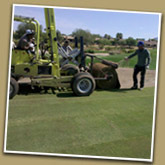When to Replace Turfgrass Sod and How to Extend Its Life
Tuesday, March 12th, 2024Installing the right type of sod grass on your property can help it look attractive throughout the year. However, you may have to replace sod grass after some time. While you can take steps to optimize the lifespan of your grass, replacing it will eventually be necessary.
The best way to learn about when to replace sod grass is to discuss the topic with a supplier. An expert can provide recommendations specific to the variety of turfgrass sod you’ve chosen for your property. That said, the following overview will provide general advice to help you better understand this topic in the meantime.
Replacing your lawn: What You Need to Know
Deciding whether it’s time to install new sod requires accounting for various factors. They include the following:
- Lawn condition: Many types of sod grass are quite durable. For example, sod for sports fields can stay in good shape for a relatively long stretch of time. That said, long-term wear-and-tear can have a negative impact on your sod’s condition and overall appearance over the years. You might want to replace your sod if this has occurred.
- Choose a new and improved variety: Perhaps you’re unhappy with your current sod. Maybe you want to swap it out for a better choice, something that stays green longer, uses less water, or grows better in the shadow of that tree that is now 20 feet taller than when you first planted it. Discuss this topic with a supplier if so. They can explain your options and explain the process of replacing one variety of sod grass with another.
- Weeds: If your lawn is overrun with weeds, you may need to lay down new sod to tackle the problem and prevent it from returning. However, you will also have to kill all the weeds first before doing so. Coordinate with an expert to ensure thorough results.
You can technically lay most varieties of sod during virtually any season, but it is best to select a variety that is most suited for the time of year and local conditions. A knowledgeable sod supplier can help you with this decision.
Tips for Extending the Life of your Lawn
Ways to keep sod grass in the best possible condition for as long as possible include:
- Discuss proper maintenance and care with suppliers, and adhere to their suggestions. Purchase any maintenance equipment you may need ahead of time. Establish a lawn maintenance schedule so you don’t overlook this.
- Make sure water reaches every spot on your lawn during the watering process.
- Minimize foot traffic and other forms of traffic on your sod. True, you may have selected a particular variety of sod primarily because it can stand up to substantial foot traffic. However, no sod is completely invulnerable to harm. Don’t operate heavy vehicles on your sod when you can avoid doing so, and consider installing walking paths to guard against excessive foot traffic.
- Wait at least two weeks to mow new sod. Mowing too soon can damage the root. Ask a professional the ideal time to start mowing your chosen sod variety.
That last point reiterates an essential truth: Discussing these topics with sod suppliers is the easiest way to learn about replacing old sod and extending your current sod’s life. Contact a professional if you’re not sure whether it’s time to replace your sod. Along with answering your basic questions, they can supply your new sod and may even suggest a different variety if you’d like to try another style.
Contact Turfgrass Sod Suppliers in Arizona
At Evergreen Turf, we offer numerous varieties of sod for properties ranging from homes to sports venues. Learn more about our products and services by contacting us online today!

